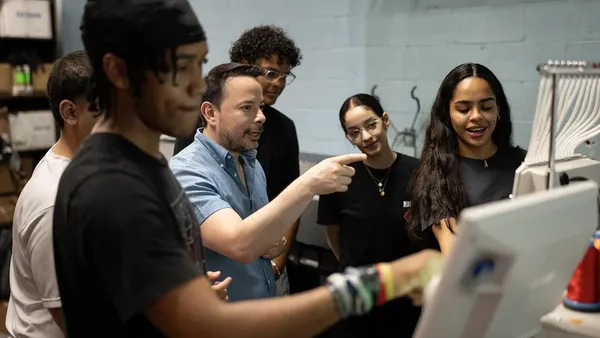Report after report reveals learning gaps exacerbated by the pandemic. And while educators are working hard to address unfinished learning, there are many challenges to ensuring each student gets the support they need to progress.
One of those challenges is trying to manage and make sense of the various assessment data that states, districts and individual teachers collect to support decision-making and the communication of students' progress to families. To plan instruction, teachers are often tasked with creating their own activities to understand how students and classes are performing. Districts typically create or purchase common, periodic assessments to identify students who need additional support, evaluate program effectiveness or allocate resources, while states provide data back to districts and teachers on student performance on statewide summative assessments.
While these formative, interim and summative assessments fall under the umbrella of a "balanced assessment system," they often provide disparate data across multiple platforms, which hinders actionable, efficient and effective decision-making. Balanced assessment systems also may not incorporate measures such as social emotional learning surveys or screeners that reveal additional insights for informing instructional strategies.
"We see districts using multiple assessment products, on different platforms and for different purposes. The issue is trying to compile that information in a meaningful way to support kids," said Trent Workman, senior vice president of school assessment for Pearson's school assessments business unit. A more comprehensive and coherent approach to assessment, one that goes beyond the notion of being balanced, "helps to remove the barriers that occur when trying to apply data-driven decision making," Workman said.
Here is what educators should know about the strategic use of assessments.
A new assessment model that promotes enhanced learning outcomes
As with any industry, education has its own lingo, and the word assessment can mean different things to different people, Workman said. Balanced assessment systems have long been seen as a panacea, but they often don't work as effectively as they should when the formative, interim and summative data are used in isolation or are disconnected by all components not being aligned to a state's academic standards. Not including additional data (such as universal screeners and diagnostic and social emotional learning assessments) as part of this more comprehensive system may lead to a decision that doesn't take into account the needs of the whole child — and therefore could be less effective.
Another issue is that assessments are often developed by a variety of stakeholders, including vendors, teachers, and school or district leaders. Often these assessments prioritize different knowledge, skills and abilities. They may or may not be connected to instruction or curriculum, and especially with an assessment product, have varying levels of rigor and statistical quality or the data we know about the items and tests themselves. The result can be confusion and contradiction when looking at the scores.
That's why Pearson is pivoting to a new comprehensive and cohesive assessment design model structured to give consistent data that helps educators make better decisions. "We are creating the future of assessments, where a district implements a system that has been thoughtfully designed in a way that the data points and assessments work together to provide a full picture for the district, school, individual educators, and parents and caregivers," Workman said. Ideally, he added, this will require less testing time because it will provide more meaningful data while removing overlaps.
The solution extends beyond academic measures to include skills-based and nontraditional inputs, such as those that measure social and emotional well-being, along with skills like collaboration and communication. The goal is to implement a modular system of assessment that accounts for the needs of balanced assessment but goes a step further with a robust set of measures and is configurable within a single platform.
"Our focus is on ensuring the time spent on assessment actually accelerates learning versus taking time away from instruction," Workman said. "With the proper type of data and reporting, assessments allow teachers to differentiate instruction and schools to better allocate resources, including tutoring supports, to enhance student outcomes."
The assessments also prioritize culturally relevant content to improve student engagement and equity. In addition, the content has undergone rigorous reviews for alignment to state standards, to ensure the avoidance of bias and sensitive issues, as well as psychometric analysis of the items by subgroup. These processes are common for summative assessments, but Pearson believes this level of quality must be coherent across all sets of content, including its formative solution.
"We stand behind our research to confirm the data we're putting in a teacher's hand is reliable and that the activity will be purposeful for all students, even if that data is being used for lesson planning for the following day," Workman said.
Professional development supports assessment goals
Even the best assessment tool needs to be accompanied by robust professional development. While the district or state may have a wealth of knowledge about the purpose of each assessment, resources need to be packaged and delivered to teachers to make the best use of its results.
"Embedding assessment literacy and professional development ahead of using the tool allows us to more fully cover the assessment's purpose, its uses and explain why it's a good use of student's time," Workman said. "We also thoroughly explain how our easy-to-use interface and reporting tools can help teachers discover actionable data and use it in the classroom."
For example, he said, reports can pinpoint the specific standard or objective on which students need support, allowing teachers to group students for accelerated learning. By showing educators exactly how students performed on a given item, they can identify misconceptions and offer targeted feedback to more efficiently clarify the concept.
Expanding communication outside the classroom
Educators and students are just two legs on the stool. It's also crucial families and caregivers understand student progress throughout the year. To meet that need, Pearson embedded a family portal within the assessment tool that makes it easy to supply results to caregivers. It even streamlines the process for educators to send a personalized video unique to the student in a family's home language.
"Other stakeholders would benefit from a more thorough grasp on why and how assessment tools are used," said Workman, who recommends schools consider the potential for providing assessment literacy to the greater community. "We see a lot of misconceptions about assessment coming from conversations at board meetings or among neighbors or from the media," he said.
Districts can help ensure assessments deliver on their promised value by proactively communicating the purpose and use of specific assessments and sharing measurement data. "Community members, policymakers, state leaders and other stakeholders should understand the goals of assessments and how a comprehensive program can contribute to improving learning outcomes," Workman said.
Leveling up your assessment program
As schools look to the 2022-2023 school year, many administrators know they need to shift from reactive to proactive models. That's where implementing a comprehensive, cohesive assessment system can help uncover new opportunities to close learning gaps and help students thrive. "A robust assessment system is critical to ensuring schools have the tools they need to measure performance and yield actionable data they can use in the classroom," Workman said.
To learn how Pearson can help your school improve its assessment system, visit Pearson.com.










